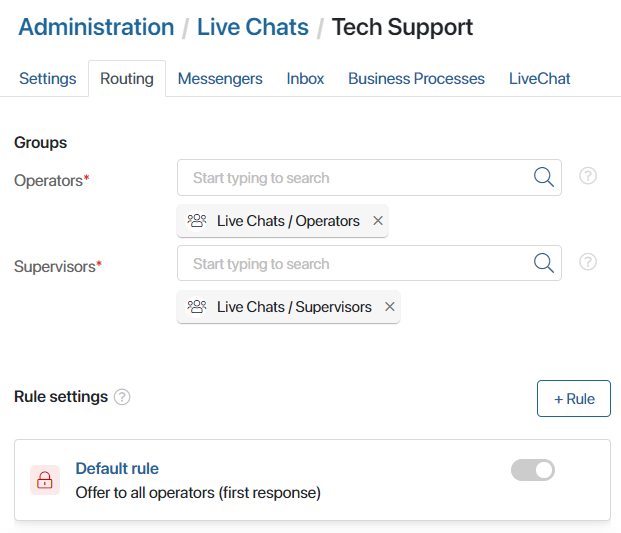You can change the list of employees who distribute sessions in a live chat.
You can also create custom routing rules that can be used to automatically distribute new sessions among certain operators or operator groups. For example, all requests received before the lunch break can be assigned to one group of operators, and the ones received after the break, to another group.
Note that routing rules are not applied to new sessions automatically marked as spam.
начало внимание
Only users included in the Administrators group can change the lists of live chat supervisors or operators and configure routing.
конец внимание
To edit the lists of employees who work with a live chat and to set up create routing rules, do the following:
- Go to Administration > Live Chats.
- Select a live chat from the list or create a new one by clicking the +Live Chat button in the upper right corner.
- Switch to the Routing tab.

- In the Groups section, determine which groups of employees will work with the live chat.
- Operators*. Groups of employees who reply to messages from the live chat. These employees can take sessions from the queue and view the sessions they are working on.
- Supervisors*. Groups of employees who oversee the work of operators. These employees have access to all sessions in the live chat and can assign operators to sessions.
- In the Rules section, you can see the Default rule. Each new session it is applied to is added to a single common queue. It is assigned to the operator who is the first to start working on it.
You can create custom routing rules. To do that, click +Rule.
- In the window that opens, set the parameters:

- Rule name*. Enter a name for the new rule.
- Activity*. In the drop-down, select an action that will be performed when the conditions set below are met:
- Assign to the least occupied operator in the group. The users in the group are checked, and the one having the least number of active sessions at the moment is selected. The new session is assigned to this operator. If you choose this option, the field for selecting an operator group appears. It is only possible to select groups specified in the Groups section of the settings.
- Invite all operators in a group. The new session is added to the queue for operators from a specific group. If you choose this action, a field for selecting a group of operators appears. It is only possible to select groups specified in the Groups section of the live chat’s settings.
- Invite all operators. The new session is added to the common queue for all operators working with the live chat.
- Assign an operator. The new session is automatically assigned to a specific operator. If you choose this option, a field for specifying the operator appears.
- Assign to the “last” operator. The session is assigned to the operator who replied to this client the previous time. This activity appears in the list if you created the condition First session with the client = No.
- Create Conditions. In this section you can set the routing parameters:
- Attribute. Click Select an attribute and specify the session property whose value will be checked in the condition.
- Operator. Select a comparison operation that will be used when checking the condition from the list.
- Value. Set a value for the property from the Attribute column. For example, for the Time property, you can enter 1:00 PM and set ≤ as the comparison operator. Then all messages received before the lunch break will be assigned to a specific operator or group of operators.
To create an additional condition, click +Add Condition. A new row for setting a condition appears. You can also see the logical operation that connects each two conditions checked within the rule:
- AND. For the rule to apply, both conditions have to be met.
- OR. At least one condition has to be met.
- OR NOT. Both conditions must not be met.
- AND NOT. The first condition has to be met, but the second one must not be met.
To group several conditions, check the boxes next to them and click the Group button.
- Click Create.
The rule you created can be edited, copied, or deleted. To do any of these things, click the ![]() icon to the right of the rule and select an action.
icon to the right of the rule and select an action.
Whenever a new session is created within the live chat, it will be checked against the conditions in each routing rule. The rules are applied in the order they are placed on the settings page, from top to bottom, until one of the rules works.
Note that if according to the routing rules a session needs to be assigned to a specific operator, but at that moment this user’s status is Offline, the rule is not applied.
If the session is not allocated using any of the configured rules, the Default rule is applied to it. The session will go to the common queue for all operators.
To change the order that the rules are applied in, simply drag them to new positions.
Found a typo? Highlight the text, press ctrl + enter and notify us